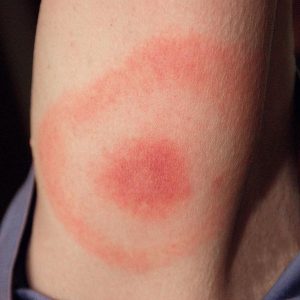Lyme Disease

Lyme disease is the fasting growing vector-borne infectious disease in the United States according to the CDC. It was first identified in 1975 after tiny ticks were discovered to be infected with the bacterium. If you’ve found a tick on yourself, don’t panic. Knowing the symptoms what to do should reduce your chances of getting sick, and what to do to receive treatment promptly.

Lyme disease is transmitted through the bite of an infected black legged tick, often referred to as the deer tick. There has been no evidence that Lyme disease can be spread from person to person. Deer ticks are small and can range in size from a poppy seed to one-eighth inch long. The average deer tick is around the size of a sesame seed! They can be picked up in in wooded and grassy areas, including yards where they wait to latch onto a host. They favor hosts like the white-tailed, squirrels, and other rodents.
Ticks can attach to any part of the body but are often found in areas such as the scalp, armpits, waist band, and groin. It usually takes 24 to 48 hours for a tick to infect their host. The length of time is dependent on the type of tick and germs it is carrying. The risk for Lyme disease is lower if a tick has been attached for less than 36 hours.
Showering after being outside reduces the likelihood of a tick attaching. It’s also a great time to do a full body tick check! If you find a tick crawling on you that has not attached or is not full of blood, you should be safe from germs. However, it could be a sign that there are others. Don’t delay! Do a careful tick check.
According to the Center For Disease Control if you have been bitten by an infected tick, many early cases can be treated successfully with a few weeks of antibiotics.
Common symptoms of Lyme disease include:
- fever
- chills
- headache,
- fatigue
- muscle and joint aches
- swollen lymph nodes
- skin rash

Seventy to eighty percent of all individuals with Lyme disease develop a characteristic skin rash called erythema migrans (ER). Over time, ER can enlarge and may resemble a target or bullseye. However, it should be noted, that many people may only notice a large red rash. If left untreated, the infection can spread to joints, the heart, and the nervous system.
It is important to be on the lookout for symptoms for 30 days after a tick bite. Lyme disease can feel similar to the flu, so it’s a good idea to call your doctor if you notice any flu like symptoms in the summer months. They will be able to test and correctly diagnose Lyme disease.
Days to months after a tick bite, signs and symptoms may include:
- severe headaches and neck stiffness
- additional rashes
- arthritis with severe large joint pain (knees) and swelling
- facial palsy (loss of muscle tone on one or both sides)
- intermittent tendon, muscle, joint and bone pain
- heart palpitations or irregular heart beat
- dizziness or shortness of breathe,
- inflammation of the brain and spinal cord
- nerve pain, numbness or tingling in hands and feet,
- and short term memory problems.
Two keys to avoid tick-borne infections are to reduce exposure to ticks, and to check for ticks daily and remove them as quickly as possible. You and your family can take several steps to prevent and control Lyme disease: include reducing tick habitat, dressing appropriately, removing ticks promptly, and treating your property for ticks.
If you have questions or are looking for organic options to treat your yard for ticks, contact us or call (513) 687-5991. Follow Native Shield on Facebook and Instagram for news and tips to help you stay ahead of the buzz!
